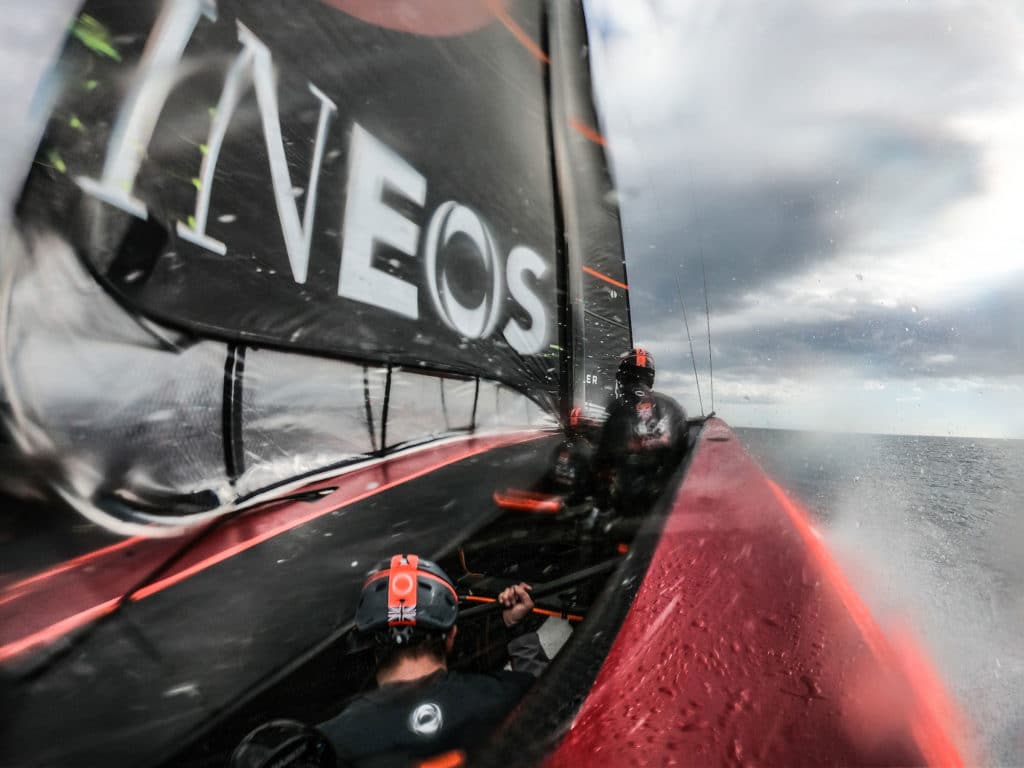
What’s different about the AC75 is that the rules impose a maximum weight — a very different concept to the minimum weight that might be more familiar to most sailors. The problem when designing and building an AC75 is the same in both cases. It requires meticulous management of weight during the whole process. The consequences, however, are very different. Anyone bringing an overweight boat to a one-design regatta will be sailing at a disadvantage, but anyone turning up at the America’s Cup with an overweight boat won’t be racing at all…until cleared by the scale.
The weight limit for the AC75 is 6520 kg (14,374 lbs.), that’s not including sails or crew. However, 3,358.5 kg (7,403 lbs.) of that is supplied by the event organizers; in the foil arms, the cant system, media equipment and supplied rigging. The teams only have 3,161.5 kg (6,968 lbs.) to play with; so that’s less than half the weight of the boat that they can control.
The AC75 rule also sets limits on the positions of different components and overall centers of mass and so this must also be monitored. It all makes weight management a much tougher job than with a more open rule.
“There’s no doubt that controlling weight effectively is a critical part of winning this America’s Cup,” says Ben Ainslie, skipper and team principal at INEOS Team UK. “There’s no give or take in the rule, if it’s not down to weight, we will have to remove equipment before the race, and that might mean critical performance-related gear.”
All the teams will have made someone accountable for monitoring the weight of the boat. At INEOS Team UK it’s naval architect Alan Boot. “His job is to record everything that goes onboard the boat, from the bolts on the instrument displays to the drive train assembly and so on. He’s really our weight police,” Ainslie explains.
“If we divide the boat into sub-assemblies like rig, rudder, foils, systems, composite structure, and so on, then the design team with the responsibility for an area will keep Booty updated on the parts and weights as they go from the best estimate or the concept weight, to an as specified or constructed weight.”
The sophisticated engineering and design tools now available have made this job a lot easier than it used to be. “We use 3D modelling to provide relatively accurate weights of parts before they’re built. And then everything is weighed as it’s completed to keep the overall weight calculation up to date, and the intent is to see any problems coming early and avoid them,” Ainslie says. “Booty has done a very good job in what is — as you can imagine — a challenging role.”
The volume and complexity of the structure of the boat has a big impact on hitting the weight target; for example, a high-volume boat will be harder to get down to weight than a low-volume boat. “The other big thing is probably the systems or the electronics and hydraulics that allow us to control the boat, and this is a big area where the cost can really rack up when you’re trying to save weight. You have to be very, very careful, specifically in this area. One thing we did in the last campaign, for example, was to use titanium hydraulic pipes to save weight.”
Perhaps fortunately, this particular weight-saving strategy has been banned in the current rules.
There are two other important weights that are listed in the rule, one of them being the crew-weight limit. This is 960 to 990 kilograms (2,116 to 2,182 lbs.) for the 11 crew members. “We have an average crew weight of 90 kilos (198 lbs.) per man, or per crew member. But we want to make the people controlling the boat as light as possible as they’re not putting as much into winding the handles and generating the power. It’s those guys [grinders] we want to be as heavy as they possibly can be to maximize the power output,” Ainslie says.
So, along with the wing trimmer and pilot, Ainslie is now on a weight loss program. “When I sailed the Finn, I was probably about 15 kilos (33 lbs.) heavier than what I am now. So, I’m on the other end of the spectrum where I’m trying to get the weight off, and that’s really about having the right diet and lots of long duration, low intensity aerobic workouts to burn off that fat.”
The final weight in this section of the class rule is the weight of the equipment that the crew are allowed to carry onboard, which is 55 kilos (121 lbs.) for the 11 people. “It means we can only really carry five kilos (11 lbs.) of weight onto the boat to go racing, and that includes all of the clothing, communications and safety equipment. So that’s wetsuits, shoes, life jackets, any of the built-in crash protection, the helmet, spare air, knives, radios, headsets, sunglasses. And any food and water. So, we’ve had to work really hard with our suppliers, they’ve been fantastic in helping us keep this weight down and get within that weight target.”









